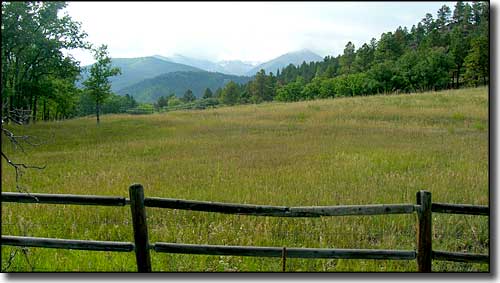 |
|---|
Agricultural Issues - Managing Your Pasture |
|
|
 |
|
Small pastures are too easily over-grazed, and often are the most abused grazing lands in an area. To protect against this, you need to decide how you want your pasture to look: a mix of grasses and shrubs, shrubs only or grasses only. Over-grazing (too many grazing animals on a patch of land for too long) leads to weed infestations, unproductive pastures, bare ground and soil erosion. Goats and sheep prefer brush and green leafy plants over grass and will graze these plants, making them less prominent. Cattle and horses will search out the most palatable grasses and leave the brush, shrubs and less palatable grasses behind. Beyond using different animals to naturally shape the vegetation, remember the "take half - leave half" principle: allow the animals to graze half the forage and leave half to regrow the forage. A second principle involves the time of grazing: grazing too early in the spring weakens the forage. The least critical time for grazing is late summer and fall, as long as the forage is not so consumed that its growing point is damaged. You'll also want to allow your pasture to go to seed regularly and replenish itself that way. Because of the variabilities of soil and climate, annual dryland pasture production can vary from 300 to 1,000 pounds of air-dry forage per acre. Irrigated pastures can produce 1,000 to 6,000 pounds of air-dry forage per acre. Grazing animals daily eat 2 to 3 percent of their body weight of air-dry forage. A 1,000 pound cow needs about 25 pounds of air-dry forage daily, or about 750 pounds monthly, under ideal conditions. Using 1,000 to 1,200 pounds of air-dry forage per month per animal is more realistic when calculating feed expenses. A pasture's total carrying capacity can be estimated by taking the weight of air-dry forage and dividing by two (take half, leave half). This gives you the pasture's total available forage production. Then calculate the forage needed to sustain your animals for one day. Divide the pounds of forage available by the pounds of forage needed per day to determine the number of days during growing season that the pasture can sustain grazing. This is where most folks back up because it requires more feed than they thought. Then they have to deal with decreasing the number of animals, increasing pasture production, increasing pasture harvesting efficiency, or providing supplemental hay. So then, the rules:
|
|
|
 |
| Index - Arizona - Colorado - Idaho - Montana - Nevada - New Mexico - Utah - Wyoming National Forests - National Parks - Scenic Byways - Ski & Snowboard Areas - BLM Sites Wilderness Areas - National Wildlife Refuges - National Trails - Rural Life Advertise With Us - About This Site - Privacy Policy |
| Photos courtesy of Sangres.com, CCA ShareAlike 3.0 License. Text Copyright © by Sangres.com. All rights reserved. |